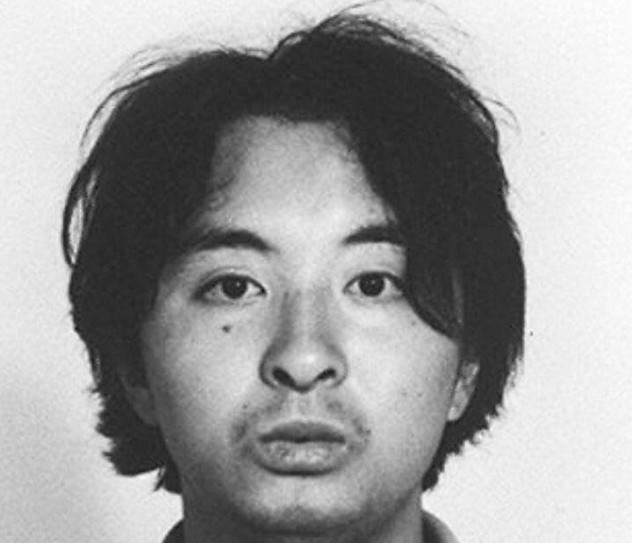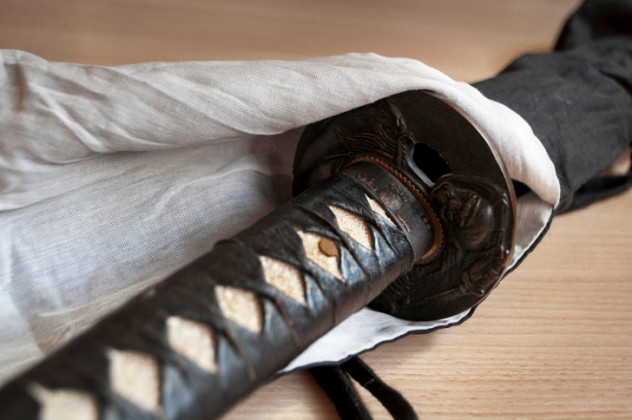 Creepy
Creepy  Creepy
Creepy  Movies and TV
Movies and TV 10 Movies That Get Elite Jobs Right, According to Experts
 Weird Stuff
Weird Stuff 10 Times Real Laws Were Based on Bizarre Hypotheticals
 Animals
Animals 10 Inspiring Tales of Horses Being Human
 Mysteries
Mysteries Top 10 Haunting Facts About the Ghost Ship MV Alta
 History
History 10 Surprising Stories About the Texas Rangers
 Humans
Humans 10 Philosophers Who Were Driven Mad by Their Own Theories
 Miscellaneous
Miscellaneous 10 Video-Game-Worthy Weapons and Armors from History
 Weird Stuff
Weird Stuff 10 Psychics Who Accurately Predicted Wartime Events
 The Arts
The Arts 10 Pieces of Art Inspired by a Broken Heart
 Creepy
Creepy 10 Death Superstitions That Will Give You the Creeps
 Movies and TV
Movies and TV 10 Movies That Get Elite Jobs Right, According to Experts
 Weird Stuff
Weird Stuff 10 Times Real Laws Were Based on Bizarre Hypotheticals
Who's Behind Listverse?

Jamie Frater
Head Editor
Jamie founded Listverse due to an insatiable desire to share fascinating, obscure, and bizarre facts. He has been a guest speaker on numerous national radio and television stations and is a five time published author.
More About Us Animals
Animals 10 Inspiring Tales of Horses Being Human
 Mysteries
Mysteries Top 10 Haunting Facts About the Ghost Ship MV Alta
 History
History 10 Surprising Stories About the Texas Rangers
 Humans
Humans 10 Philosophers Who Were Driven Mad by Their Own Theories
 Miscellaneous
Miscellaneous 10 Video-Game-Worthy Weapons and Armors from History
 Weird Stuff
Weird Stuff 10 Psychics Who Accurately Predicted Wartime Events
 The Arts
The Arts 10 Pieces of Art Inspired by a Broken Heart
10 Nerdy Loners Who Went Disturbingly Wrong
It’s indisputable that contemporary Western culture is awash in depictions of bespectacled, socially awkward dweebs. From The Big Bang Theory to any romantic comedy you can think of, entertainment is dominated by dorky protagonists and the dorky writers and artists who create them. For the time being, the world belongs to the meek, credentialed, and lonesome.
Given that most geeks are depicted as harmless, this list may shock you. A word of warning, this list isn’t meant to accuse all self-professed nerds of being ticking time bombs, but simply to highlight a series of strange crimes connected by the obsessive natures of the people who committed them.
10Tsutomu Miyazaki

The crimes of Tsutomu Miyazaki, which came to light in 1989, were so horrendous that they almost buried an entire subculture. In the aftermath, Miyazaki, a troubled young man who owned a private video library of some 5,763 titles, most of which were incredibly violent horror and pornographic films, became the public perception of a nerd gone wrong. Known in Japan as otaku, this subculture was already poorly characterized in the Japanese press for the supposed social aloofness of its followers. It was further ostracized when Miyazaki was labeled the “Otaku Killer.”
While Miyazaki’s obsessive interest in gore cinema probably didn’t help his mental state, it’s also true that Miyazaki was a dangerous individual long before becoming an otaku. Despite being born into a respectable and affluent family, Miyazaki was a perennial underachiever who became even more of a recluse after the death of his beloved grandfather. He suffered from more than just shyness: As a result of his premature birth, Miyazaki’s hands were withered and fused to his wrists, requiring him to move his whole forearm in order to turn them.
Between 1988 and 1989, Miyazaki went on a murder spree that gripped the entire nation in fear. All four of his victims were young girls between the ages of four and seven. Miyazaki’s methods were simple: After prowling around neighborhoods, either on foot or in his black Nissan, he would abduct the girls, murder them, molest their bodies post-mortem, then leave them to decompose in secluded areas. Miyazaki also sent taunting letters to the victims’ families, some of which included grisly mementos from the murder. It emerged during the trial that Miyazaki had also engaged in acts of cannibalism, including drinking his victims’ blood.
On July 23, 1989, Miyazaki was arrested after trying to take sexually explicit pictures of a young girl in a park. When investigators searched Miyazaki’s rooms, they found videos recorded during the murders. A calm, unrepentant Miyazaki was sentenced to death in 1997. He was executed nine years later.
9Tomohiro Kato
Contrary to popular belief, rampage killings are not exclusively an American phenomenon. Take 2008’s Akihabara Massacre, when a deranged man wielding a knife ran amok in the streets of Tokyo. The man in question was Tomohiro Kato, a 25-year-old auto worker who had been raised by a domineering mother. Kato had attempted suicide two years prior to carrying out the massacre, an action that 40 percent of all spree killers undertake before committing their final crimes. Whether or not Kato carried out the massacre as an elaborate attempt at suicide, he undoubtedly planned his killing spree with what Chief Justice Ryuko Sakurai called “meticulous preparation.”
Around noon on June 8, 2008, Kato used his rented truck to mow down shoppers in Tokyo’s Akihabara district, a mecca for manga, toys, anime films, and other otaku-type products. After his initial strike, Kato left his battered vehicle and began hacking and slashing at pedestrians with a large knife. All in all, Kato managed to kill seven people, ranging in age from 19 to 74. He was arrested at the scene after a brief chase.
At his trial, Kato, an obsessive user of Internet message boards and chatrooms, explained that “I wanted people to know that I seriously wanted to stop the harassment on the Internet bulletin board that I used.” Kato was sentenced to death in 2011. Interestingly, Kato, a loner who attacked one of the major gathering centers of the otaku subculture, may have helped to expedite the execution of “Otaku Killer” Miyazaki after the Japanese authorities decided to reassure a nervous public about the resolve of the criminal justice system.
8Caleb Fairley
On September 10, 1995, Lisa Manderach decided to spend her Sunday shopping with her 19-month-old daughter Devon. When they didn’t return, Lisa’s nervous husband contacted the police, who quickly zeroed in on a store called Your Kidz & Mine. Lisa and Devon had been seen inside the store, which was owned by the Fairley family, on the day of their disappearance. At the time, the only person minding the store was 21-year-old Caleb Fairley.
The case become even more serious after hikers in Valley Forge National Park discovered Devon’s body. An on-scene investigation revealed that her corpse had been thrown from the access road above the park’s hiking trail, indicating that she had been killed elsewhere before being discarded. The autopsy found that she had been strangled to death.
After bringing in Caleb Fairley for questioning, investigators noticed that he was wearing makeup. Underneath it, they found scars consistent with fingernail scratches, leading them to believe that Lisa Manderach may have fought back. Although he initially claimed that he had received the scars from a mosh pit, Fairley ultimately confessed to killing Lisa and Devon. As part of a plea bargain, he showed investigators where he had dumped the nude body of Lisa Manderach.
During the investigation, detectives discovered that Fairley, who was a devotee of such role-playing games as Dungeons & Dragons and Vampire: The Masquerade, had a deeply unhealthy obsession with vampires. It is believed that Fairley’s fantasy world became so powerful that it drove him to murder Lisa, who bore a notable resemblance to the beautiful brunette woman depicted being attacked on Fairley’s favorite vampire-themed t-shirt.
7Allan Menzies

When it was released in 2002, Queen Of The Damned, an adaptation of an Anne Rice novel starring the ill-fated pop star Aaliyah, was widely panned. Most critics despised it, and the public apparently agreed. Rice herself was open about the fact that the film was a monumental mistake. However, there was one man in Scotland who thought very highly of the film. In fact, he claimed that it drove him to kill.
On December 11, 2002, Allan Menzies, a 22-year-old resident of Fauldhouse, West Lothian, stabbed 21-year-old Thomas McKendrick 42 times and drank his blood in order to become a vampire. Menzies, who reportedly watched Queen Of The Damned hundreds of times, claimed that Akasha, the ancient vampire played by Aaliyah, had visited him in his bedroom on numerous occasions prior to the crime. According to Menzies, not only did Akasha promise him immortality as a vampire, but she also told him that McKendrick and another friend named Stuart Unwin were planning on killing him. Supposedly under the spell of Akasha, Menzies used a hammer, a bowie knife, and a kitchen knife to kill McKendrick.
Menzies was sentenced to life imprisonment by an Edinburgh jury in 2003, before ending his sentence by committing suicide in November 2004.
6Ashlee Martinson
Until March 8, 2015, folks around Piehl, Wisconsin, thought Ashlee Martinson was an unremarkable 17-year-old. On that date, Martinson and her boyfriend, 22-year-old Ryan Sisco, were tracked down and arrested in Indiana, charged with killing Martinson’s mother and stepfather.
Martinson, who maintained a horror- and goth-themed blog called “Nightmare” under the name VampChick, supposedly decided to kill Jennifer and Thomas Ayers after a heated argument concerning Martinson’s relationship with the older Sisco. When Thomas Ayers went upstairs to confront Martinson, she allegedly shot him. Jennifer Ayers then ran upstairs to investigate, only for Martinson to attack her with a knife. Martinson then locked her three sisters, aged between two and nine, in a room with some food and juice. She then took a shower and fled the scene.
What remains of Martinson’s profile on social media highlights her deep interests in the goth subculture, heavy rock, and horror films. To what extent this will factor in her trial remains to be seen.
5Trey Eric Sesler
Known to a small Internet following as Mr. Anime, a YouTube-based anime film reviewer, Trey Eric Sesler shot and killed his mother (Rhonda), his father (Lawton), and his brother (Mark) at their family home on March 20, 2012. Sesler, a 23-year-old native of Waller, Texas, confessed after the murders that he had killed all three because he was planning to carry out a Columbine-like massacre and didn’t want his family to know about it. When police entered the house, they found messages scrawled on the walls, including “I love my mom, dad and brother” and “God forgive me, because I cannot forgive myself.”
While not watching hours upon hours of anime films, Sesler studied and even graded mass shootings. He also descended deeper and deeper into criminal activity, including arson, killing pets, and shooting at empty buildings. Fortunately, the bodies of his family were found shortly after the murders and Sesler was arrested later that day. The local police chief, Phil Rehak, said he was sure Sesler would have otherwise gone through with his plan to commit a massacre: “We prevented something horrific from possibly happening. I think I can say that with pretty high confidence.” After entering a guilty plea in the summer of 2012, Sesler was sentenced to life imprisonment.
4Gary Scott Pennington

Described by his classmates as a “nerd” and a “loner” due to his high intelligence and his propensity to read alone, Gary Scott Pennington was actually a deeply troubled individual. This became obvious in the worst possible way on January 18, 1993, when Pennington pulled out a .38-caliber pistol and shot his high school English teacher dead.
The killing took place in the rural Appalachian town of Grayson, Kentucky. The victim, 48-year-old Deanna McDavid, was a veteran instructor at East Carter High School. On the day of the shooting, McDavid was seated at her desk. In front of her were some 22 pupils tasked with a reading assignment. When Pennington barged in carrying his disabled father’s handgun (which he had earlier stolen from underneath the older man’s bed), he told McDavid to “shut up” and called her a “bitch” before shooting her twice in the head.
In the aftermath of the crime, many media outlets pointed out the similarities between Pennington’s actions and those of Charlie Decker, a fictional school shooter in Stephen King’s 1977 novel Rage. Because of this negative media attention, along with subsequent school shootings and hostage situations, King eventually pulled Rage from bookshelves everywhere, vowing that it would never be printed again.
3James Egbert III
Believe it or not, Dungeons & Dragons was once considered cause for moral panic. The spark that lit the culture war began with the disappearance of James Dallas Egbert III, a 16-year-old student prodigy at Michigan State University, who went missing in the university’s steam tunnels in 1979. According to many, the shy Egbert had gone down into the tunnels in order to play a live-action version of his favorite game: Dungeons & Dragons. In truth, Egbert went into the steam tunnels in order to commit suicide. After being discovered, Egbert would attempt suicide a few more times before finally dying of a self-inflicted gunshot wound in August 1980.
The case became a cause celebre after William Dear, a private detective hired by the Egbert family, asserted that Egbert had died during a Dungeons & Dragons game “gone wrong.” Of course, Egbert wasn’t dead at all, but that didn’t stop the panic. In 1984, Dear published a highly sensational account of the case called The Dungeon Master, while CBS Television aired a made-for-TV movie called Mazes And Monsters, which starred Tom Hanks as a young man so obsessed with role-playing games that he loses his mind. Without question, the case of James Egbert III and the backlash against D&D helped to create the “Satanic panic” of the 1980s, which focused public scorn on such nerdy loves as heavy metal, comic books, and board games.
2Kimveer Gill
According to those who knew him, Kimveer Gill was an unambitious 20-something who liked Jack Daniels whiskey and recreational drugs. He was also obsessed with 9/11 conspiracy theories, the US invasion of Iraq, heavy metal music, the goth subculture, and the Columbine massacre. But his big obsession was guns.
On September 13, 2006, Gill, armed with a pistol, a carbine, and pump-action shotgun, shot and killed a Dawson College student and wounded 19 others. He then killed himself as Montreal police closed in on his firing position inside the college’s atrium. Seeking a motive, investigators found that Gill maintained a highly detailed presence on several social media websites. In particular, Gill regularly posted at VampireFreaks.com under the name “fatality666.” On his VampireFreaks profile, Gill regularly wrote screeds decrying work and school, while championing “goth girls, goth everything, Germany, first person shooters, my knife, blood, rain, ravens, crows, fire, destroying my enemies, semi-automatic handguns, combat shotguns, assault rifles and the Grim Reaper.”
Besides posting disturbing images of himself holding various weapons, Gill, who posted on the site as often as every 15 minutes, made references to his plans to carry out an attack, causing significant criticism of the website.
1Joseph Hunter Parker

Rather than a firearm, Joseph Hunter Parker attacked an Irvine, California, supermarket with a samurai-style katana. Around 40–50 shoppers were inside when the 30-year-old Parker, who wore a beret and a trench coat during the attack, began his bizarre assault. During his onslaught, Parker managed to kill two of his former co-workers and wounded three more people before police could shoot him dead in aisle 11. A former bagger at the store, Parker had been known for his erratic behavior but was generally regarded as harmless.
A diagnosed schizophrenic, Parker, who had quit his job just two weeks prior to the crime, was reportedly obsessed with the Highlander film and television series. As part of this obsession, Parker was an avid collector of medieval sword replicas. The motive for the attack has never been conclusively proven, but it probably lies somewhere between Parker’s mental disorder and his inability to separate fantasy from reality.
Benjamin Welton is a writer based in Boston. His work has appeared in The Atlantic, The Weekly Standard, Listverse, Metal Injection, and others. He currently blogs at literarytrebuchet.blogspot.com.








